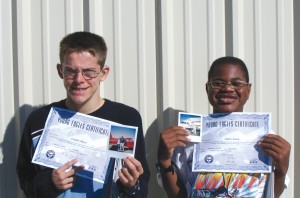
L to R: Frankie Meyer and James Anton proudly display their Young Eagles certificates. Students at the Colorado School for the Deaf and Blind, they took flights in 2004 as part of EAA Chapter 72’s Young Eagles flights for the hearing impaired.
Thousands of young people will take to the sky on Saturday, June 11, as EAA volunteers continue an outstanding aviation tradition—International Young Eagles Day. The annual event brings together children and pilots as part of the EAA Young Eagles program, the largest youth aviation education program ever created, which has flown more than 1.1 million young people free of charge since its inception in July 1992.
Each year since 1994, approximately 10,000 young people are flown on or around International Young Eagles Day. The flights are provided by volunteer EAA-member pilots in aircraft ranging from the newest airplanes to vintage biplanes. Such interesting aircraft as gliders, helicopters and even hot air balloons and blimps have also been used for Young Eagles flights.
More than 37,000 pilots have volunteered to support the program, including current program chairman Harrison Ford. The well-known actor and aviator has personally flown nearly 200 Young Eagles and is an outspoken advocate for the program.
“Aviation has provided me enjoyment and challenges,” Ford said. “Flying can be a great teacher and motivator for young people. I encourage my fellow EAA members to give the gift of flight to a young person, especially on International Young Eagles Day. It is certainly an experience you’ll both remember.”
During International Young Eagles Day, pilots will fly young people on individual flights or as part of Young Eagles flight rallies, which often bring together hundreds of youngsters and dozens of aircraft in many communities.
The Young Eagles concept has been so successful became it’s simple. A young person between the ages of eight and 17 is matched with a volunteer pilot. The pair then does a preflight “walk-around” of the aircraft, where the pilot explains the parts of the airplane and how they work. After reviewing the preflight safety checklists that pilots use prior to every flight, the pair takes off for a brief flight (typically 15-20 minutes) to experience the true sensation of flying an airplane.
After landing, the young person receives a Young Eagles certificate signed by the pilot and Harrison Ford. The new Young Eagle’s name is then entered into the “World’s Largest Logbook” that is on permanent display at the EAA AirVenture Museum in Oshkosh, Wis.
This year, Young Eagles are also encouraged to explore a new website—www.youngeagles.org—designed especially for them. Along with the World’s Largest Logbook, the Young Eagles website is filled with interactive activities, games, aviation information and much more to support aviation interest among young people.
“Young people still have enormous curiosity about flying,” Ford said. “I’m an active Young Eagles pilot because I know it makes a tremendous difference to these youngsters, not only because of what they learn during the flight, but the possibilities that are opened to them through our volunteers’ efforts. That’s why I urge every pilot to be a part of the Young Eagles program.”
The EAA Young Eagles program is made possible through the participation of more than 80,000 pilot and ground volunteers, and also through the support of Jaguar Cars.
For more information about Young Eagles, whether your interest is as a pilot, parent or young person, explore [http://www.youngeagles.org] or call 877-806-8902.











